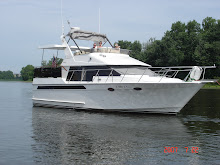
Helm of the S/V Peacemaker

Architecture around Wilmington, NC

Architecture around Wilmington, NC

Architecture around Wilmington, NC

20' tall giant sloth skeleton found in Wilmington.

Noah Genda docked next to the boardwalk

Young crew member doing repairs on Peacemaker

150' Tall ship "Peacemaker", all wood construction, built in Brazil in 1989

Freighter being unloaded in Wilmington

We set an alarm Sunday night so we could get an early start (6:25am) departing Myrtle Beach SC, since we had 70+ miles to get to Wilmingtonon NC located 20 miles up Cape Fear River. Leaving that early didn’t help us because we missed the opening of the Sunset Beach Pontoon Bridge (0 clearance) by 5 minutes. Since it only opens on the hour we had to wait 55 minutes for the next scheduled opening! On today’s trip we left South Carolina and entered North Carolina at mile ICW MM 340.9. The ICW is extremely narrow in this area and it is a "No Wake" for quite a distance. A couple of the inlets are challenging with misplaced or missing navigational aids as well as some very shallow water.
The 202 mile long Cape Fear River is named for the dangerous Cape Fear shoals off Bald Head Island, near the river's mouth. It flows southeast to the Atlantic Ocean but when the tide comes in from the ocean it fights the river flow and causes some major rocking of our boat here at the City Docks in Wilmington.
At the turn of the century, majestic sailing ships delivered treasures from around the world to the Port of Wilmington. An example of a tall ship is currently docked in front of us. The Peacemaker is 150’ with 126 feet high masts. I’ll let Tom describe the rest to you. The vessel was constructed in 1989 in Brazil by a Brazilian industrialist for him and his family to sail the world. After launch and very little use the original owners idea was abandoned and the vessel sat in the Palmer Johnson yard in Brunswick, Georgia while it deteriorated for the next few years. A world organization titled “Twelve Tribes” purchased the vessel in 2000 and spent the next seven years totally refurbishing it into what you see today. Quite a remarkable achievement by a volunteer group of sailing enthusiasts. They currently tour the entire East Coast of the U.S. offering free tours in communities they visit along the way. The craftsmanship is absolutely stunning. This was a very educational tour.
Cotton was king and one of the largest and busiest cotton export companies in the world was located here. The Cotton Exchange is eight restored buildings connected by brick walkways; open air court-yards housing 30 specialty shops and restaurants. I only made it to one store and had so many packages I couldn’t carry them on my bike. I had to call Tom to meet me with his bicycle and basket. The Cotton Exchange was the first downtown complex in North Carolina to adapt and utilize existing buildings, serving as an excellent example of local preservation.
Wilmington area is still one of the major US ports for freighters. As we arrived, it was interesting to see them unload box cars with what looked like a magnetic crane and load them immediately on a semi that was sitting there waiting. For more than a century, railroading was Wilmington’s chief industry and was the center of commerce with warehouses filled with naval supplies, tools, cotton and turpentine. The wharf was destroyed by fire in 1840 but the wharf has been restored to the Old South feeling.
I toured a museum and found out that Michael Jordon was born in Brooklyn NY but went to school and grew up here in Wilmington. The dining has been great here. There are over fifty restaurants in Wilmington and not one chain/franchise restaurant in the downtown historic district. We had time to sample three restaurants and they were great.
I love this area!

No comments:
Post a Comment